1 The Origin of Earth
Nahgeib Miller
Learning Objectives
After completing this chapter, you should be able to:
- Explain the scientific method and its application to scientific investigation and insight.
- Explain the origin of the solar system and Earth within the context of the scientific method.
- Explain the early Earth and how it became a differentiated planet.
- Define the principles of geology.
- Describe the difference between geologic time and human time frames.
1.1 Introduction
With every advance in technology comes a change in human thinking as our perception of the universe and our place in it is refined. Our technology allows us to perceive the universe beyond our five senses, challenging us to explain what we observe. These observations are explained through the scientific method, which employs critical thinking.
To us the Earth seems old and unchanging, when in fact it has gone through many periods of upheaval and catastrophic changes, long before humans inhabited it. Through the rock record, geologists have been able to estimate the age of the Earth to 4.56 billion years and to determine that there have been at least two periods when supercontinents dominated the planets topography. Through technology, we have even been able to determine the origins of our universe about 14 billion years ago!
The origin of our Earth is explained within the context of scientific observations and the explanations thereof.
1.2 The Scientific Method
Have you ever been in an argument and your antagonist decides to quote “scientific facts” as a means to prove a point? The person quotes some esoteric scientific discovery that cannot be refuted or challenged. This is a fallacy of “scientific” discourse because all things known through scientific discovery are constantly and rigorously subjected to challenge and continued investigation. To call something a “scientific fact” is to suggest that there is nothing more to know about that thing. Therefore, this book will posit that there are no “scientific facts”: everything that is known can be better understood as our technology and cognitive abilities advance.
In order to understand how the universe works, all scientific investigations in every scientific discipline (geology, chemistry, physics, biology, and so on) employ the scientific method. This is a way of employing critical thinking to elucidate even the most complex natural phenomena.
In using the scientific method, we first make an observation of a phenomenon, whether through experimentation or in a chance encounter in nature. Based on empirical evidence, we must then come up with a tentative explanation of what is causing the phenomenon using inductive reasoning (that is, we make a generalization — going from the specific to the general). This tentative explanation is called a hypothesis. There is a myriad of ways to explain an observation, but a good hypothesis has the following attributes:
- The hypothesis must be testable. Whatever the explanation, there should be available technology and ability to run experiments to confirm or refute it.
- It should be parsimonious. The simplest explanation is the most appropriate explanation. The hypothesis should be sparing and refrain from complexity.
- It should be elegant. It should explain more than one phenomenon in nature or, in the absence of natural observation, it should fit the predictions of other prevailing explanations (unless you have discovered something ground-breaking!).
The next step is to make a prediction of something that should occur according to the observer’s hypothesis. That is, we use deductive reasoning (going from the general to the specific) to make a statement about what should be observed in a new experiment based on the tentative explanation (the hypothesis). If the prediction is not confirmed, then the hypothesis must be revised or discarded (Figure 1.1).
If the prediction is confirmed, and if subsequent predictions are also confirmed through experimental observation, then the hypothesis gains prominence and is elevated to a theory. This is as good as it gets in science. Yet even though many people will treat highly regarded theories as “fact,” theories are open to challenge, revision, or refutation. Highly regarded theories have, however, survived many challenges and have confirmed many predictions around a number of natural phenomena.
For example, Newtonian physics (Isaac Newton’s three laws of motion, 1686) work well at predicting the movement of objects on Earth but do not accurately predict the movement of massive objects like planets. On the planetary scale, Newtonian physics was supplanted by Einstein’s theory of special relativity (note that this is still a theory today — and that it was advanced by Albert Einstein in 1905); however, at the quantum scale, special relativity breaks down and cannot predict the movement of subatomic particles. It has, in turn, been supplanted by quantum mechanics. The scientific community has acknowledged that these theories are flawed and will be revised or discarded in the future, but they are still useful when applied to technology and engineering. Even though Einstein’s theory of special relativity is flawed (at the quantum level), we still diligently turn left when our GPS tells us to! Our GPS systems can function accurately only when special relativity is factored in. Time flows slower closer to a massive object: if you were to place a stopwatch in space and an identical one on the surface of Earth and then start them at the same time, the one on Earth would start to lag behind the one in space!
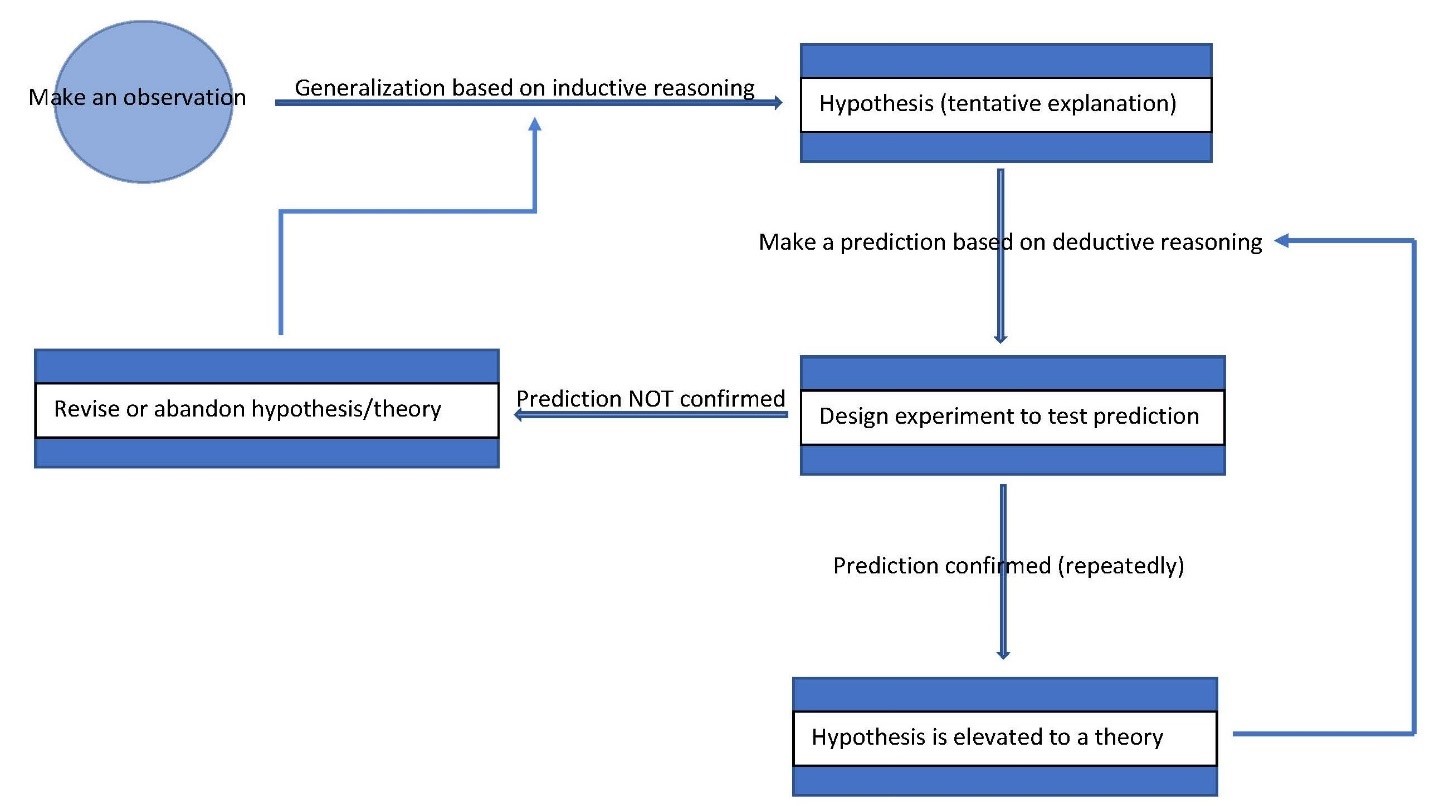
Let us use a thought experiment to gain a more practical understanding of the scientific method. Imagine that you are a shepherd and budding biologist, and you make an observation that the sheep in your care all have white coats. You may even notice that all the other sheep in your community have white coats too. You drive up the local mountain and down through the valley to visit sheep farms and make the same observation as you did on your own farm. You will likely assume that all sheep, all over the world, have white coats. This assumption is your tentative explanation or hypothesis for why all the sheep you have encountered have white coats. It is also a generalization derived from inductive reasoning, which goes from the specific (all sheep on your farm) to the general (all sheep in the world) (Figure 1.2).
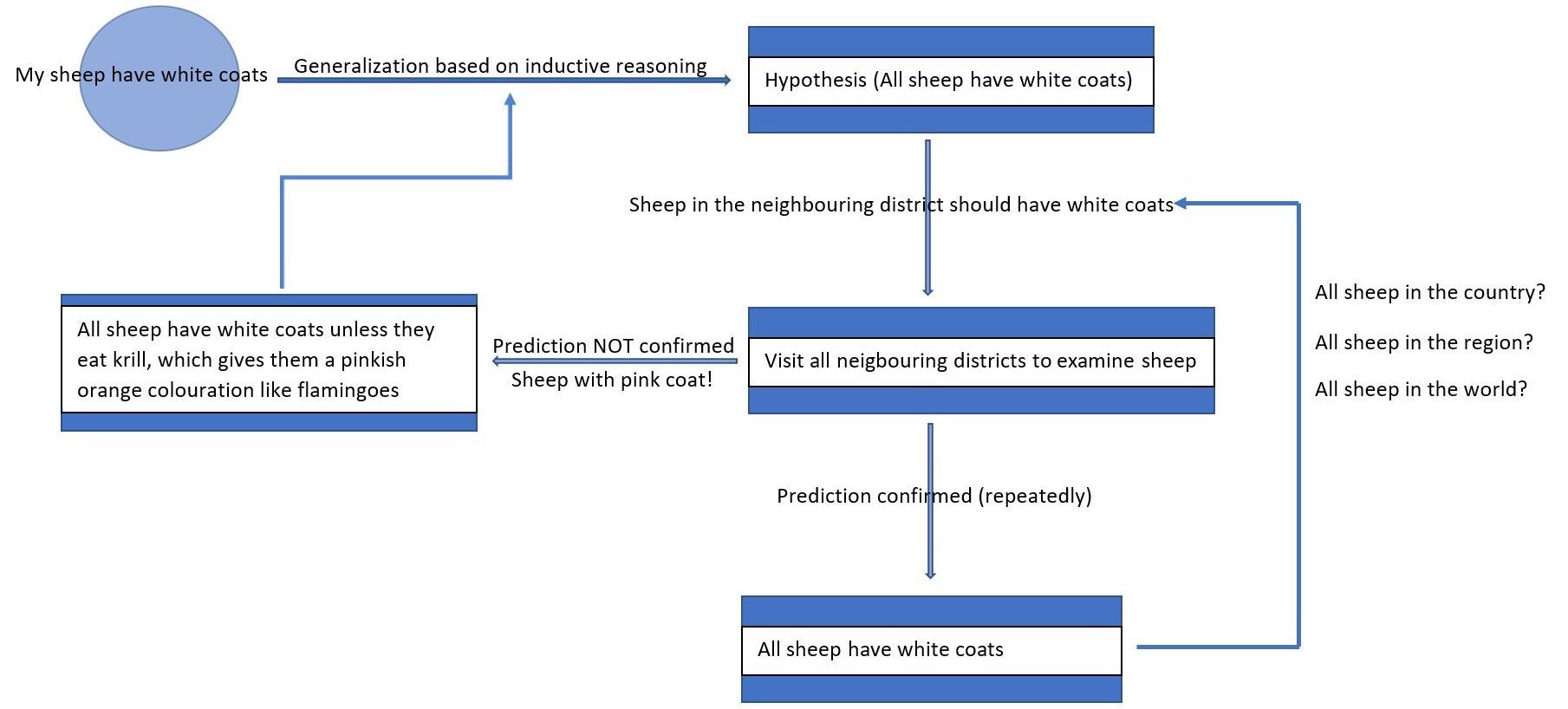
Your hypothesis could be considered a good one because it is:
- Testable You could travel around the world visiting sheep farms and observe whether the sheep all have white coats.
- Parsimonious It is the simplest explanation based on your current knowledge and understanding.
- Elegant It explains why sheep in different terrains (mountains, valleys) and geographical locations (your farm, other farms) all have white coats.
You post your paper on your white-coated sheep hypothesis in a scientific journal, and soon other biologists begin to test it, or challenge it, by making predictions and creating experiments to confirm or refute it. One person could predict that if all sheep in the world have white coats, then sheep in their area should all have white coats as well. Notice that the prediction is derived through deductive reasoning, going from the general (all sheep) to the specific (sheep in my area). If that person confirms that all the sheep in their area have white coats, then the original hypothesis gains prominence. If the hypothesis is repeatedly confirmed, then it is elevated to a theory.
For many years, let us imagine, all observations of sheep around the world report that sheep have only white coats, until one year a sheep with a pink coat is discovered! Now the hypothesis must be revised and refined to account for the possibility that some sheep have pink coats. This prompts more research to ascertain the cause of the pink coats, consider how it fits in with the prevailing white-coated sheep theory, and determine whether that theory needs to be refined or abandoned completely.
Through scientific investigation (the scientific method), we constantly peel away to the centre of truth, like an onion. Although the thought experiment above is simplistic, it highlights the iterative (repetitive) process that leads to a deeper understanding of how the universe works, recognizing that there is always deeper to go. It is with this understanding that all of the concepts expressed in this textbook are presented.
1.3 The Big Bang Theory
The Big Bang theory states that about 14 billion years ago, the whole universe existed in an infinitesimally small point and then began to rapidly expand (explode). In the first moments of its existence, our universe was too energetic for stable neutral atoms to exist. For the first about 400,000 years the universe was mostly plasma (charged particles of protons, neutrons, and electrons), which exists at a high temperature, blocking light from escaping.
As the universe expanded and cooled, stable atoms formed, allowing light to escape, and the universe became transparent for the first time. Continued expansion and cooling allowed the formation of stars, planets, and galaxies (see Video 1.1).

Click on the image to load the video.
Georges Lemaître, a priest from Belgium, first hypothesized the Big Bang in 1927, when he published a paper postulating that the universe began as a “cosmic egg” — the centre from which it has been expanding since. The Big Bang theory is the best-supported theory for the origin of the universe because it explains several observed phenomena and because predictions based on it have been confirmed through experimental observations.
One major confirmation came in 1929, when Edwin Hubble discovered that light coming from other galaxies was “red-shifted” and that the relative distance of those galaxies from ours was proportional to that red-shift. As a galaxy moves away from ours, the light coming from it will have an apparent increase in wavelength that appears as a colour shift to the red side of the light spectrum (see Figure 1.3). If the galaxy is getting closer, the light waves progressively arrive more quickly, appearing as a shorter wavelength, which appears as a shift to the blue side of the spectrum. The discovery that the vast majority (more than 99.99%) of observed galaxies are moving away from ours indicates that they must have all originated from a common point.

In 1964, Arno Penzias and Robert Wilson, at Bell Labs, made another discovery that supported the Big Bang theory, which lead to that theory being cemented and widely accepted. The pair were radio astronomers who were trying to conduct research using an antenna array when they heard an interference “hum.” After trying to eliminate all sources of potential interference — they even scraped bird droppings off the antenna — they realized that what they were seeing was the predicted thermal remnants of the universe’s birth: the light that escaped after the universe cooled about 400,000 years into its existence. We all can experience this cosmic microwave background (CMB) radiation when we try to manually tune a radio or television and hear a static “hiss” (Figure 1.4).
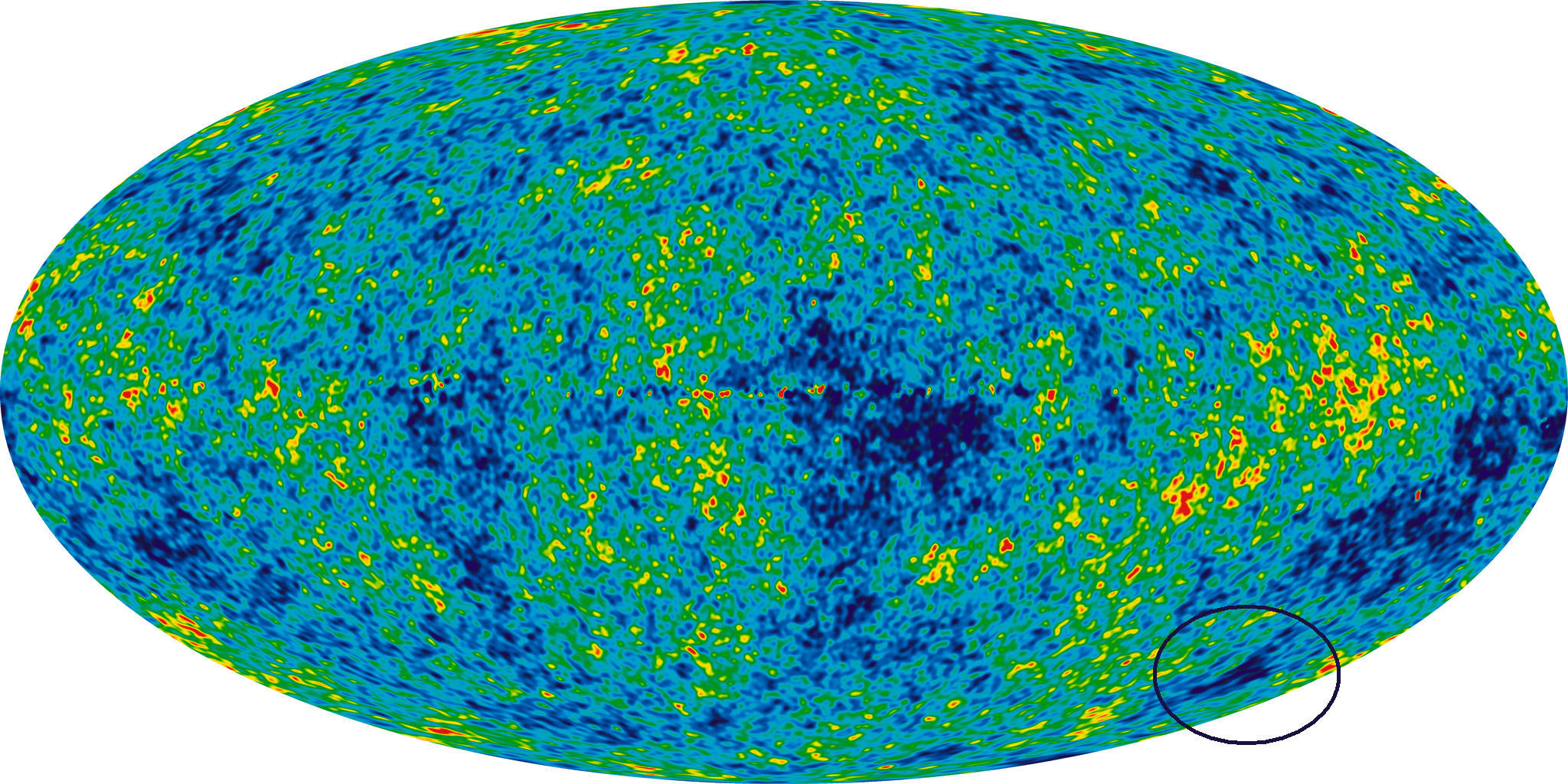
Background radiation is displayed by a detailed all-sky picture of the universe. Red indicates higher temperature; blue indicates lower temperature.
1.4 The Nebular Hypothesis
About 180 million years after the Big Bang, as the newly formed universe continued to expand and cool, new and more complex atoms begin to form and coalesce into the first stars and galaxies. Over the 14 billion years of existence of our universe since then, billions of stars have been born and have died in supernovae. These supernovae are responsible for the creation of the heavier and more complex atoms in our periodic table. That is, a supernova provided the energy required to combine more protons, neutrons, and electrons in an atom. Put simply, all of the stuff that makes up our world (trees, metals, water…) and you and me (carbon, nitrogen, phosphorus…) came from the death of a star in a supernova. We are all stardust!
The nebular hypothesis, the most widely held explanation for how our solar system formed, was first postulated by Immanuel Kant in his book The Universal Natural History and Theory of the Heavens, published in 1755. This hypothesis states that about 4.6 billion years ago, our solar system began to form from a loose, slowly rotating amalgam of cosmic dust and gas (primarily hydrogen and helium) called a nebula (see Animation 1.1). This concentration of matter and its rotation may have been initiated by energy from a nearby supernova.

Animation 1.1 Early solar system nebula and the transition to the solar system disc
Click on the image to load the animation.
The temperature at the centre of the nebula is higher than that at its edges, which causes the heavier elements with higher melting points (for example, silicon, iron, magnesium, and other rock-forming elements) to condense first. Therefore, the elements that form rock are concentrated toward the centre of the nebula, which also concentrates the mass. This leads the cloud’s rotation to accelerate, causing the nebula to flatten out into a disc. The process is similar to what occurs when an ice skater increases their rotation by bringing their arms close to their body or when an Olympic diver tucks their knees into their body. This action concentrates their mass toward their centre.
As the speed of rotation increases, the heavier elements migrate toward the centre of the nebula and the lighter elements (gases) concentrate in the outer portions. This increases the temperature in the centre of the disc. When it reaches several million degrees Celsius, the process of nuclear fusion begins, creating helium from two hydrogen atoms and releasing an enormous amount of energy as a result. Energy release from nuclear fusion in the Sun continues today, and we experience it as sunlight and heat.
The outer disc of the nebula cools, with rocky debris (mostly iron and silica) concentrated closer to the star at their centre and with lighter gases and ices concentrated toward the outer disc. The larger, more massive chunks of rocks gravitationally attract smaller pieces, which increases the size of those rock chunks, resulting in a larger gravitational attraction and causing them to grow. Eventually, the largest chunks accrete into planetesimals (small spherical bodies), which sweep up all remaining debris in their orbital path. This process is termed planetary accretion. The same process also occurs in the outer portions of the disc, where large chunks of rock and ice accrete with vast amounts of gases to create large gas giant planets. Therefore, our inner solar system is dominated by rocky terrestrial planets (from terra, the Latin word for “Earth” or “rocks”) and our outer solar system is dominated by gaseous Jovian planets (from Jove, an alternative name for the god Jupiter or Zeus in Roman mythology).
Some chunks do not get swept up. These remain as meteoroids. Meteoroids that burn up in Earth’s atmosphere become meteors, and those that reach the surface of Earth become meteorites. Earth and the Moon bear the scars of these impacts, which give an indication of how planetary accretion occurred (Figure 1.5).
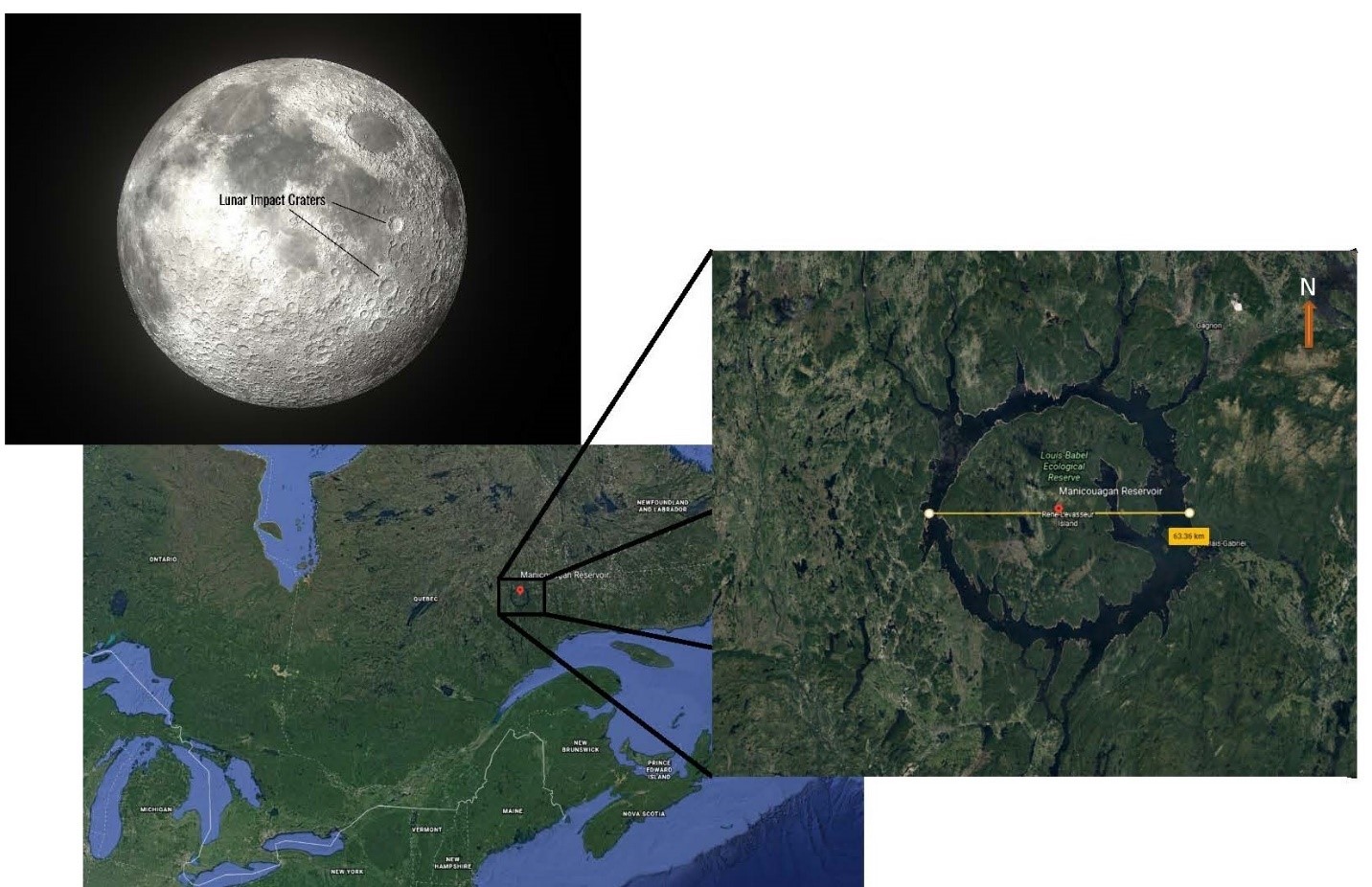
The Manicouagan Crater in Quebec was created by the impact of a meteorite about 210 million years ago, leaving a circular crater about 70 km in diameter.
The nebular hypothesis is parsimonious and elegant, as it explains the orbits of the present-day planets, the location of terrestrial and Jovian planets in the solar system, and the presence of meteoroids and asteroids (chunks of rock larger than meteoroids but smaller than a planet) (Figure 1.6).
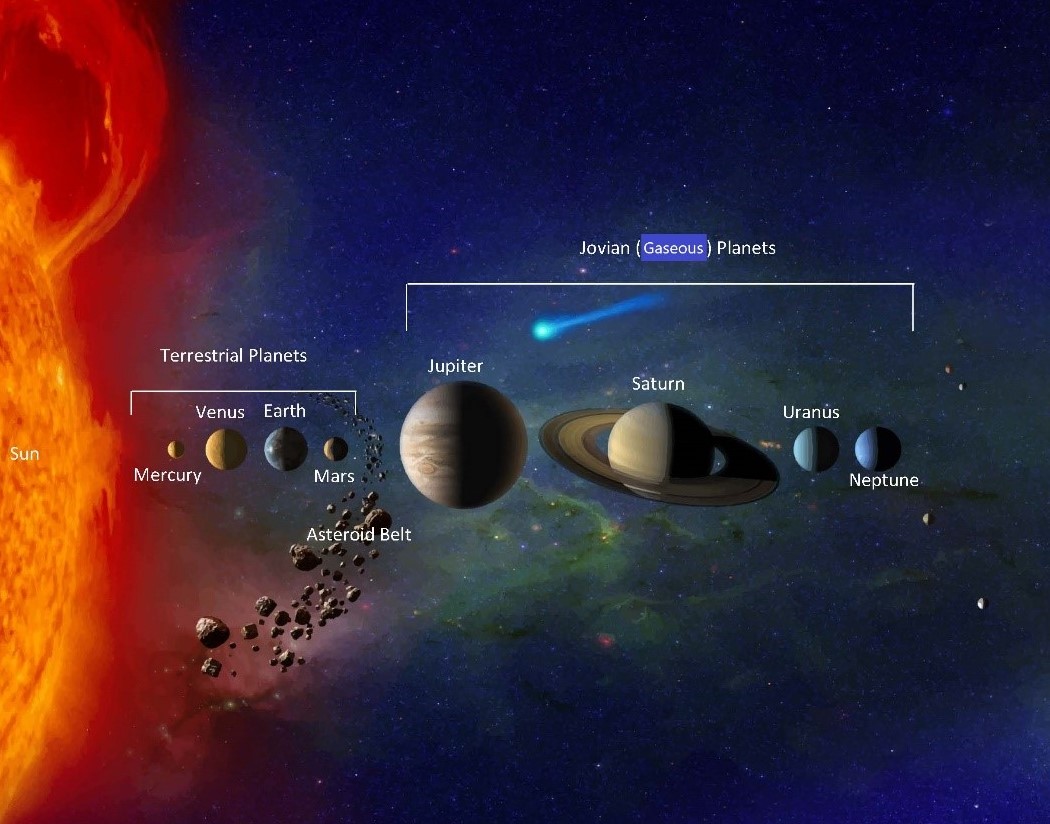
The eight planets of our solar system drawn to scale in size but not distance, in reference to the Sun. Note that between the terrestrial and Jovian planets is an asteroid belt made up of chunks of rock that never accreted into a planet. Beyond Neptune is the Kuiper Belt, which contains icy bodies and dwarf planets, including Pluto, which before the discovery of other Kuiper Belt objects was considered the solar system’s ninth planet.
1.5 Earth as a Differentiated Planet
Early in Earth’s history, about 63 million years after it initially formed (about 4.5 billion years ago), the planet was impacted by a planet-sized object, about the size of Mars. This collision had several consequences for Earth as we see it today.
Earth Was Remelted
The impact released an enormous amount of energy that was converted from kinetic (motion) energy to heat and light. Although a Hollywood movie depicting such a collision would have the sound of a big explosion, in reality there would have been only silence, because space is essentially a vacuum. The heat energy remelted the entire Earth, which lead to its differentiation into a layered planet as dense iron migrated toward the centre and lower-density materials “floated” to the surface. As Earth cooled, a thin skin or crust of solidified rock of lower density formed, encasing a medium-density semi-molten rocky mantle that surrounds a molten outer core, which surrounds a solid inner core (Figure 1.7).
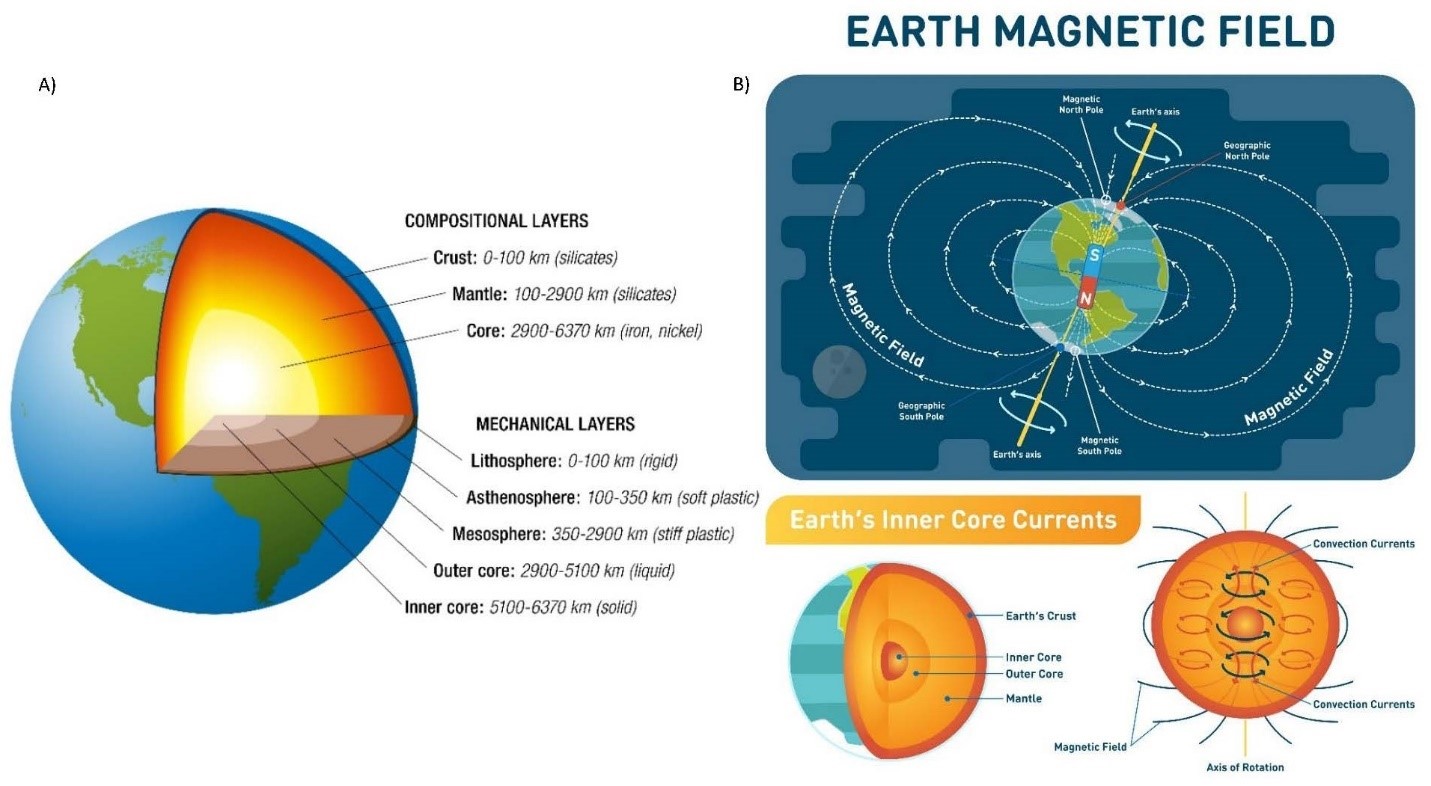
(a) Layers of Earth. (b) Magnetic field and convection currents.
The crust, or lithosphere, from the Greek words for “rocky,” lithos, and “ball” or “sphere,” sphaira, is zero to about 0–40 km deep. It is made up mostly of silicon and oxygen (silicates and oxides). Its average density is 2.9 g/cm3.
The mantle exists at about 40–2890 km depth and is made up mainly of oxygen, magnesium, and silicon. It behaves more like a ductile solid than a liquid, with an average density of 3.4 g/cm3.
The core of Earth actually exists as a liquid outer core (2890–5150 km deep) and a solid inner core (5150–6370 km deep; see Figure 1.7). The liquid outer core is mainly molten iron with some oxygen, sulfur, and nickel, and has an average density of 11.1 g/cm3. The inner core is mainly solid iron with some nickel, and has an average density of 12.8 g/cm3. The inner core is almost as hot as the surface of the Sun but remains solid due to the intense pressure at the centre of Earth. Due to the rotation of Earth, the liquid outer core is in movement around the solid inner core, which acts like a dynamo generating Earth’s magnetic field. This magnetic field is important for life as we know it because it deflects the dangerous high-energy particles streaming from the Sun. Some of these deflected particles are concentrated at the poles of the planet and we see them as the auroras (Figure 1.8).

Earth’s internal dynamo generates a magnetic field that deflects the Sun’s high-energy particles, yielding the aurora borealis, or northern lights.
The internal heat of Earth is derived from the decay of radioactive isotopes, which is redistributed by convection currents in the mantle. Heat from the outer core is transferred to the material in the deep mantle, which rises as a result. As it approaches the lithosphere–mantle boundary, it cools and sinks, to be eventually reheated at the mantle–core boundary. These convection currents are the reason the mantle does not solidify (Figure 1.9).
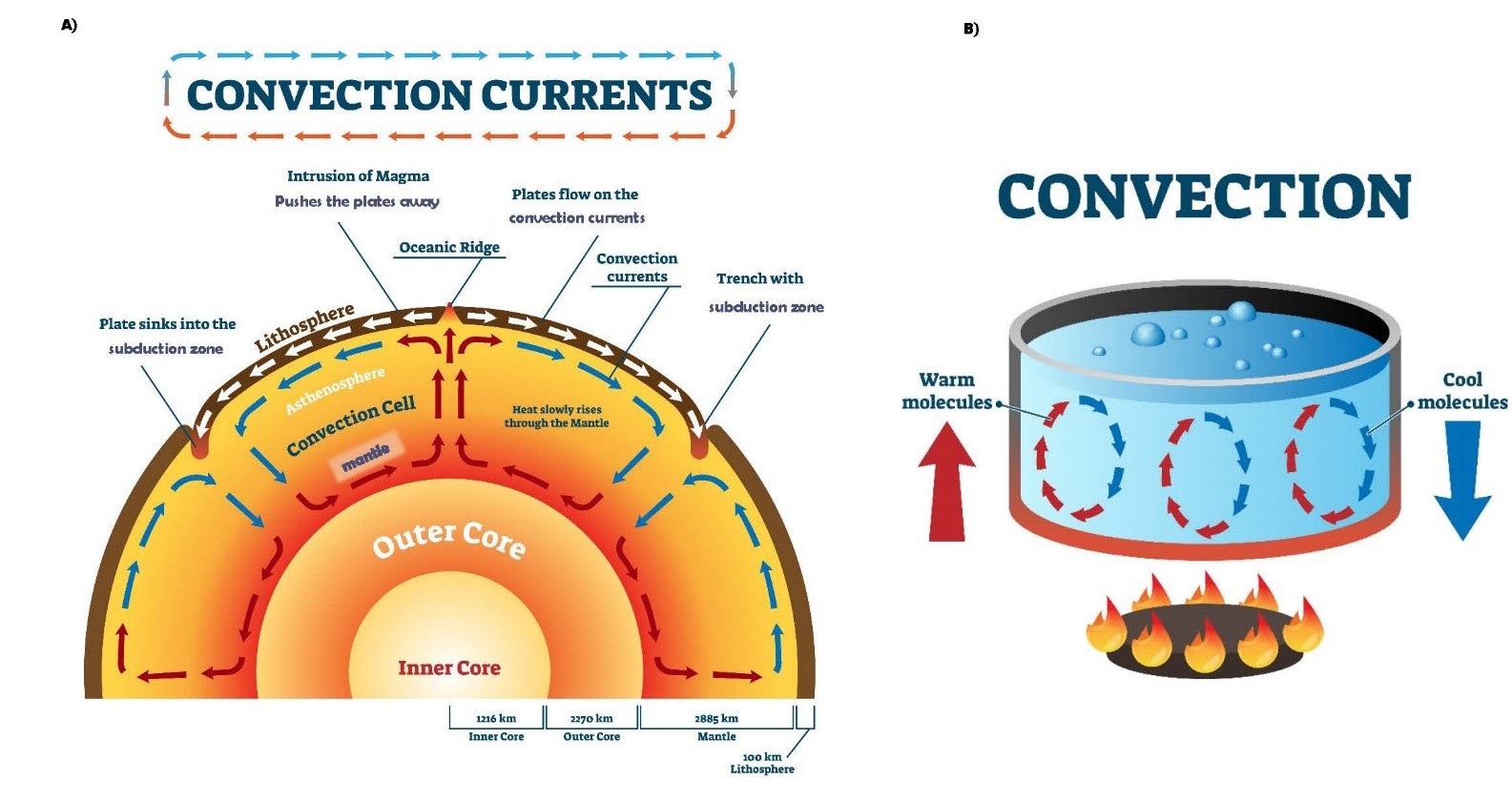
(a) Mantle convection currents. (b) Convection in boiling water.
Through repeated volcanic eruptions, several gases, including hydrogen, nitrogen, and carbon dioxide, accumulate and are held in place by Earth’s gravity, eventually forming the atmosphere. Water is also erupted and accumulates into oceans, forming the hydrosphere. It is also hypothesized that the water on our planet could have come from numerous impacts of water- bearing extraterrestrial objects, such as comets (Earth’s oceans may have developed as result of both sources of water). Earth’s biosphere developed on the basis of the interactions between the atmosphere, hydrosphere, and lithosphere (including the deep Earth — mantle and core).
With the scientific method in mind, you should recognize that the interior of Earth is under intense pressure and is too hot for humans (or any machines we have made to date) to explore in great detail and live to tell about it. So how was the internal structure of Earth understood in such detail? The understanding of Earth’s internal structure evolved with advancements in seismology in the early 20th century. At this time, with the late-19th-century invention of the geophone, or seismograph, seismologists could detect the energy generated from an earthquake, capable of travelling through the interior of Earth. The energy, in the form of seismic waves (compression waves, to be more precise) is deflected at a specific angle as it passes through boundaries between materials of different densities. Seismographs can accurately measure these deflections, which is then used to determine the number of boundaries (that is, lithosphere to mantle or mantle to core) and the densities of the layers (Figure 1.10).
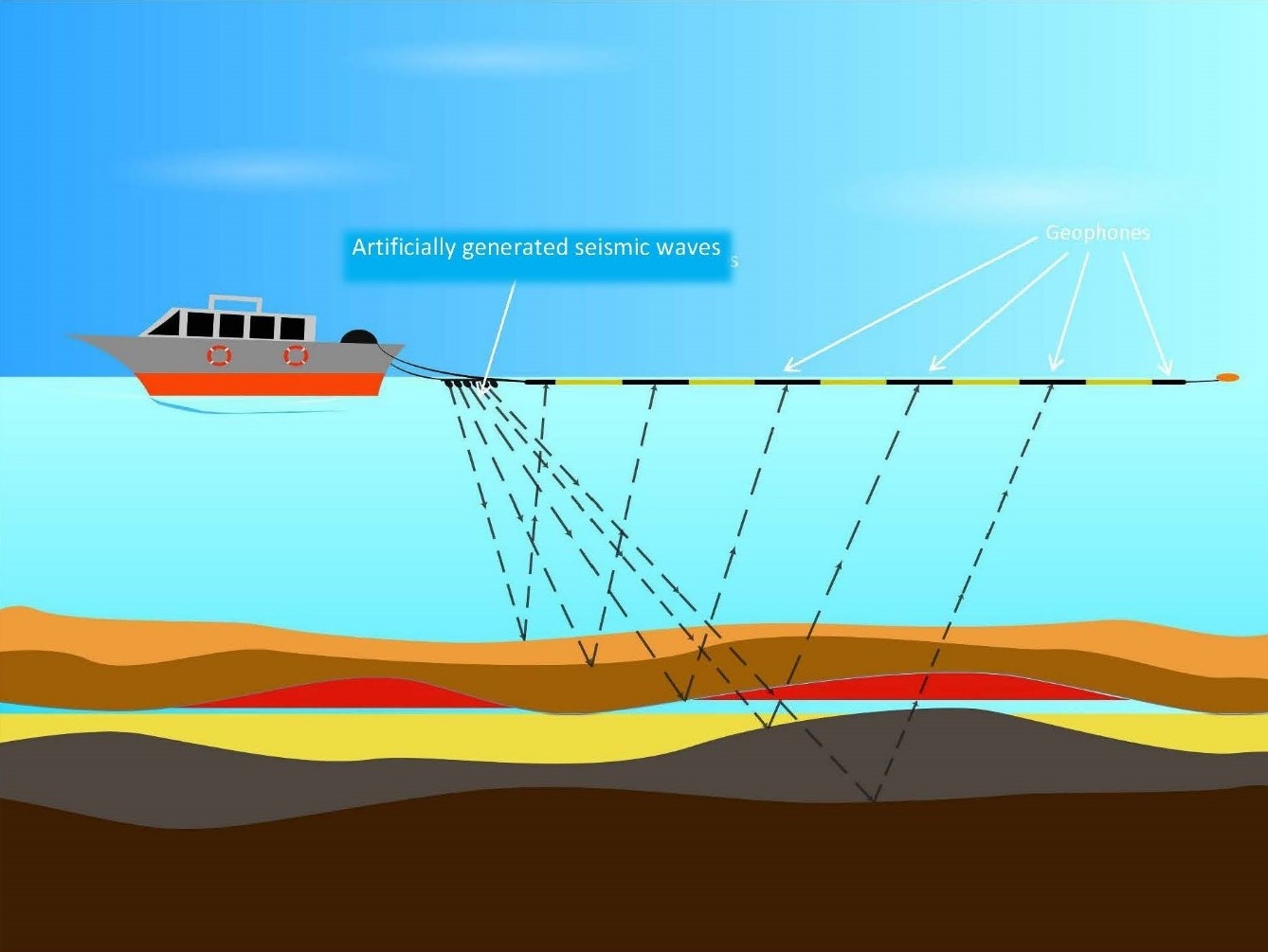
Marine seismic surveying uses the seismic energy that is refracted or reflected from each layer to determine thickness and density. This is the same principle as is used to determine the internal structure of Earth with much larger earthquake seismic energy that can penetrate to Earth’s core.
The Mars-sized impactor also caused other important occurrences that significantly influenced the present-day state of Earth in the following ways:
The Moon Was Formed
Debris from the impact was thrown into space and captured by Earth’s gravity. For a short time, Earth had rings like Saturn! The debris eventually accreted into our moon and the impacts of the latter stages of that accretion are still visible today as craters.
The Axis of Rotation Inclined
Before the impact, Earth’s axis of rotation was perpendicular to its orbital path, relative to the Sun. After the impact, the axis of rotation was inclined at about 23.5 degrees to the orbital plane. This tilt in the axial plane is what gives rise to the seasons we experience as winter, spring, summer, and autumn. In the northern hemisphere, winter occurs when the axial tilt causes Earth to tilt away from the Sun; simultaneously, the axial tilt causes summer in the southern hemisphere, which tilts toward the Sun (Figure 1.11). That means when Canada is in winter, places like Argentina, South Africa, and Australia are in summer. The tilt only marginally affects equatorial regions, which thus do not have seasons as experienced in the northern and southern hemispheres. It is essentially “summer” all year round at the equator. This is why many people living in the hemispheric regions migrate to equatorial regions (tropics) for holidays during their winter.
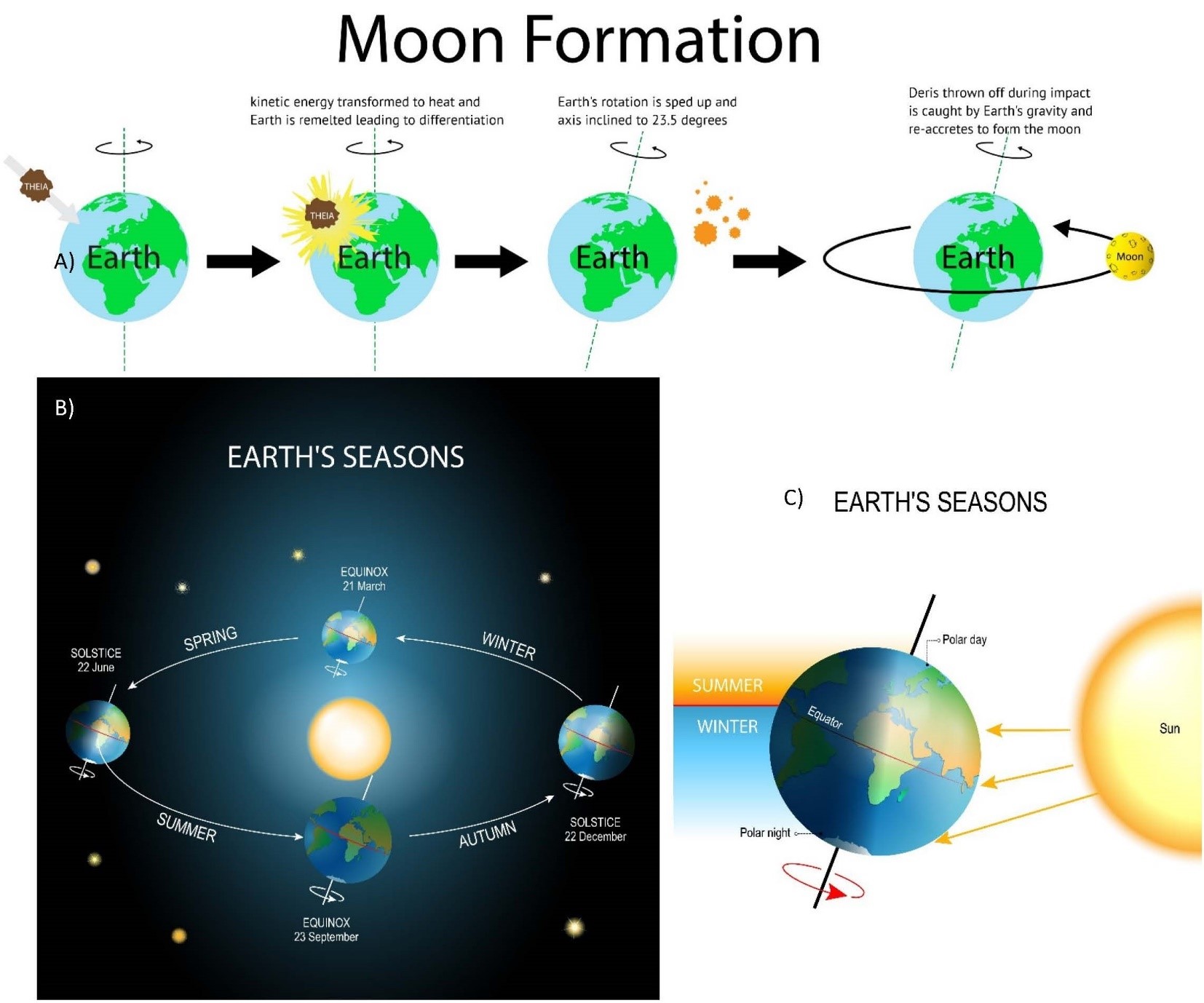
(a) The impact hypothesis. (b) Earth’s seasons. (c) How the inclined axial rotation creates the seasons.
It is important to also note that there is a “wobble” or axial precession in Earth’s axis of rotation, like when a Beyblade loses stamina. This wobble takes several thousand years to complete one precession cycle and is responsible for long-term effects in the atmosphere, hydrosphere, and biosphere such as ice ages. If we exclude the influence of volcanism and other large-scale geocycles, the beginning and end of an ice age would correspond to specific positions along the precession path (Animation 1.2).
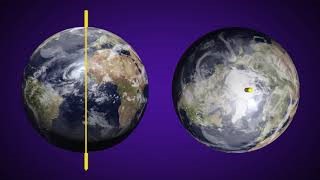
Click on the image to load the animation.
Earth’s Rotation Sped Up
The distance between Earth and the Moon was not always what it is today. In fact, today it is not what it was last year! In 1969, during their lunar missions, astronauts placed laser reflectors on the Moon’s surface, and scientists on Earth use those reflectors to calculate the Moon’s distance. This is achieved by measuring the time taken for a laser beam to travel to the Moon and be reflected back to Earth. In the initial analysis, the Moon was found to be about 384,400 km from Earth. However, after analyzing the data over the decades following the 1960s, it was found that the Moon is moving away from Earth at a rate of 3.8 cm per year. This means that the Moon was much closer to Earth at the time of its formation.
In the immediate aftermath of the impact and subsequent accretion of the Moon, the speed of Earth’s rotation increased, yielding a 4-hour day! The length of a day increased as the speed of Earth’s rotation slowed due to gravitational forces between Earth and the Moon. This produced an exchange in angular momentum that causes the speed of Earth’s rotation to decrease over time. The potency of this effect would also decrease over time as the Moon moved away from Earth.
As a result of the rotational slowing, a day on Earth now lasts approximately 24 hours (recognizing the difference between the sidereal day (23 hours, 56 minutes, 4.091 seconds) and the solar day (24 hours).
1.6 Geologic Time
In order to understand how geologic processes unfold, we have to abandon our human frame of reference for time and develop an appreciation for deep time , which unfolds over millions and billions of years. This was the very challenge facing the early pioneers in geology at a time when the age of Earth was estimated to be in the thousands of years, due to prevailing dogma.
One of the founders of the discipline of geology was a Scot named James Hutton. While observing rock exposures in Scotland during the late 1700s, Hutton mused on the processes that could cause layering and tilting. By looking at how long present-day sediments take to accumulate, he realized that the sediments in the rocks must have taken an enormous amount of time to accumulate into layers and then be tilted, eroded, and covered by yet more sediments! This led him to write, in 1788, that the history of Earth has “no vestige of a beginning, no prospect of an end.” Other geologists of the time were attempting to estimate the age of Earth using the rates of sedimentary accumulation and multiplying by the thickness of exposed sedimentary rocks. Although these estimates ranged into millions of years, which was a profound shift in understanding deep time, they were ultimately inaccurate. This is because sedimentary rock layers would be thinner than the sedimentary accumulations from which they formed, due to compression during the rock-forming process (among other things, such as different sedimentation rates based on depositional environments).
Apart from his profound quote, Hutton also advanced one of the fundamental geologic principles used to formulate an approach to dating Earth — the principle of uniformitarianism. This principle states that Earth processes unfolding today (sedimentation, erosion, rock deformation, and so on) unfolded in the same way and at the same rate in the past. That is, sediments now in the rocks in Scotland were formed in the same way that sediments would have accumulated and formed rocks long ago. This principle allows us to peel back the shroud of time and understand the processes acting on Earth from deep time until now. This is achieved by recognizing the imprints that Earth processes leave in the rock record based on how those same processes leave imprints in new rocks being formed today (Figure 1.12).

Trees at the top of the strata are about 6 m tall.
At large rock outcrops (exposures of rock at the surface of Earth), one can regularly see rocks that appear layered. Each layer is called a stratum, from the Latin word for “layer”; collectively, they are termed strata. Strata are typically deposited by running water over millions of years and can be tilted or folded by tectonic forces (we will discuss this in more detail in Chapter 2). By observing the rocks in a stratified formation, 17th-century geologist Nicholas Steno advanced the principles of stratigraphy (Figure 1.13):
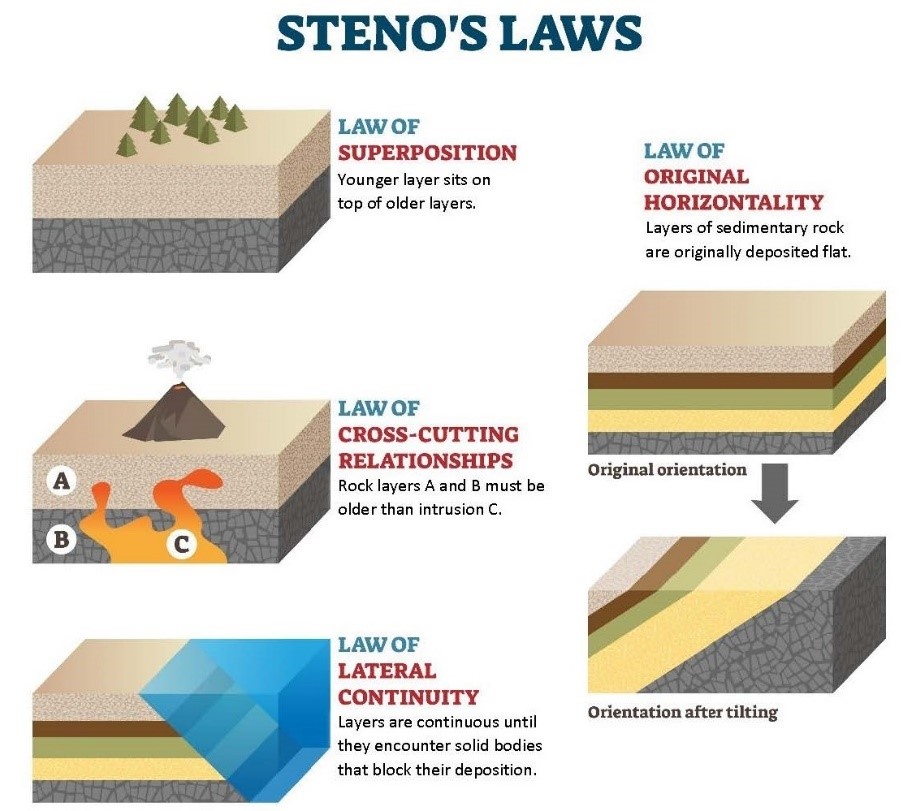
- The Principle of Original Horizontality The principle of original horizontality states that all sediments are laid down in an essentially horizontal plain, which can be subsequently tilted. Only sediments laid down at the front of a dune or at the front of a river delta would be laid down at an incline.
- The Principle of Superposition This principle of superposition states that the rocks at the bottom of a stratigraphic formation are older than the rocks at the top. That is to say, a rock layer cannot be laid down in mid-air and then younger rocks laid down under it! Sediments must be laid on top of some already existing stratum, and when these sediments solidify into rock, that rock will be younger than the rock on which is was deposited.
- The Principle of Lateral Continuity The principle of lateral continuity is based on the present-day observation that sediments are deposited in layers as far as they can be carried by the medium of transport. That is, sediment layers do not end suddenly in their lateral extent but will tend to get thinner as they approach a change in topography, such as a mountain. Therefore, we can infer that any abrupt termination of the rock layers must have been due to geologic events that occurred after the sediments were laid down. Any geologic events that lead to abrupt termination or interruptions of a rock layer represents a cross-cutting relationship.
Charles Lyell (1797–1875) used this last observation to develop one more principle:
- The Principle of Cross-Cutting Relationships Essentially, Lyell’s principle of cross-cutting relationships states that any abrupt changes to the lateral extent of strata must have occurred after sediment deposition and lithification into rock. For example, if there is an igneous intrusion into the rock, the intrusion must have come after the rock was laid down, because the intrusion could not occur in mid-air. Therefore, these kinds of relationships can be used to constrain the order of occurrence of geologic events and the age of a stratum (Figure 1.14).
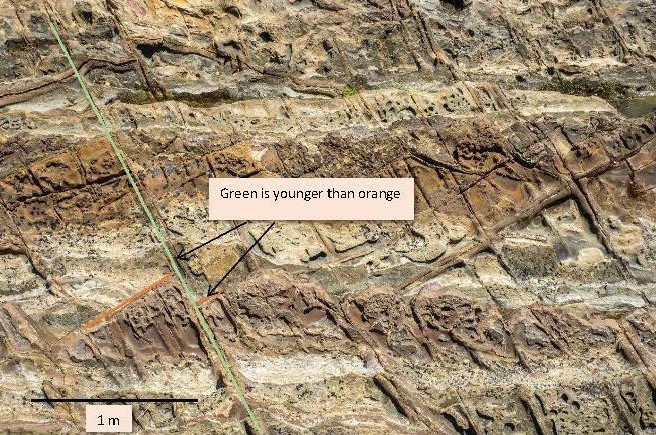
Photo by Alexander Schimmeck on Unsplash.
Unconformities
Imagine if you could cut a slice through Earth’s crust (the lithosphere) down to the boundary between the crust and the mantle. Theoretically, you would be able to see all the layers of rock that make up the crust. All of the processes that were incident on the rocks, from its time of formation to the present, would have been recorded. Through uniformitarianism and the other stratigraphic principles, you would be able to read this rock record like a book, starting from the present and going into the past or, more specifically, from the top down. However, in reality, there are “gaps” in the record representing periods when rocks were lost to erosion followed by periods of non-deposition of new rocks. Such periods appear in the rock record as erosive surfaces with younger rocks deposited on top. These surfaces represent missing time for which we have no way of knowing what Earth processes took place. Geologically, these surfaces are known as unconformities (Animation 1.3).

Click on the image to load the animation.
Fossils
Fossils are the imprints of plants and animals recorded in the rock record. These imprints are recorded when hard shells or bones become quickly encased in sediments, preserving them as the sediments transform into rock. Under certain conditions, soft parts like feathers, leaves, and skin are preserved. If we were to go back to our imagined slice through the crust and observe the rock record for fossils, we would also see the history of the animals (fauna) and plants (flora) that lived on Earth through time — well, at least the ones that could be fossilized. At the top, the flora and fauna would look similar to what we see today on Earth, but as we descended the rock record we would start to see the imprints of strange and wonderful creatures that lived long ago. In fact, we could use these fossils to correlate rocks of the same time that occur in different parts of the globe. Also, going from the bottom to the top, we would see new species succeed earlier ones through evolution. We could also trace this evolution in what is called a faunal and floral succession (Figure 1.15).
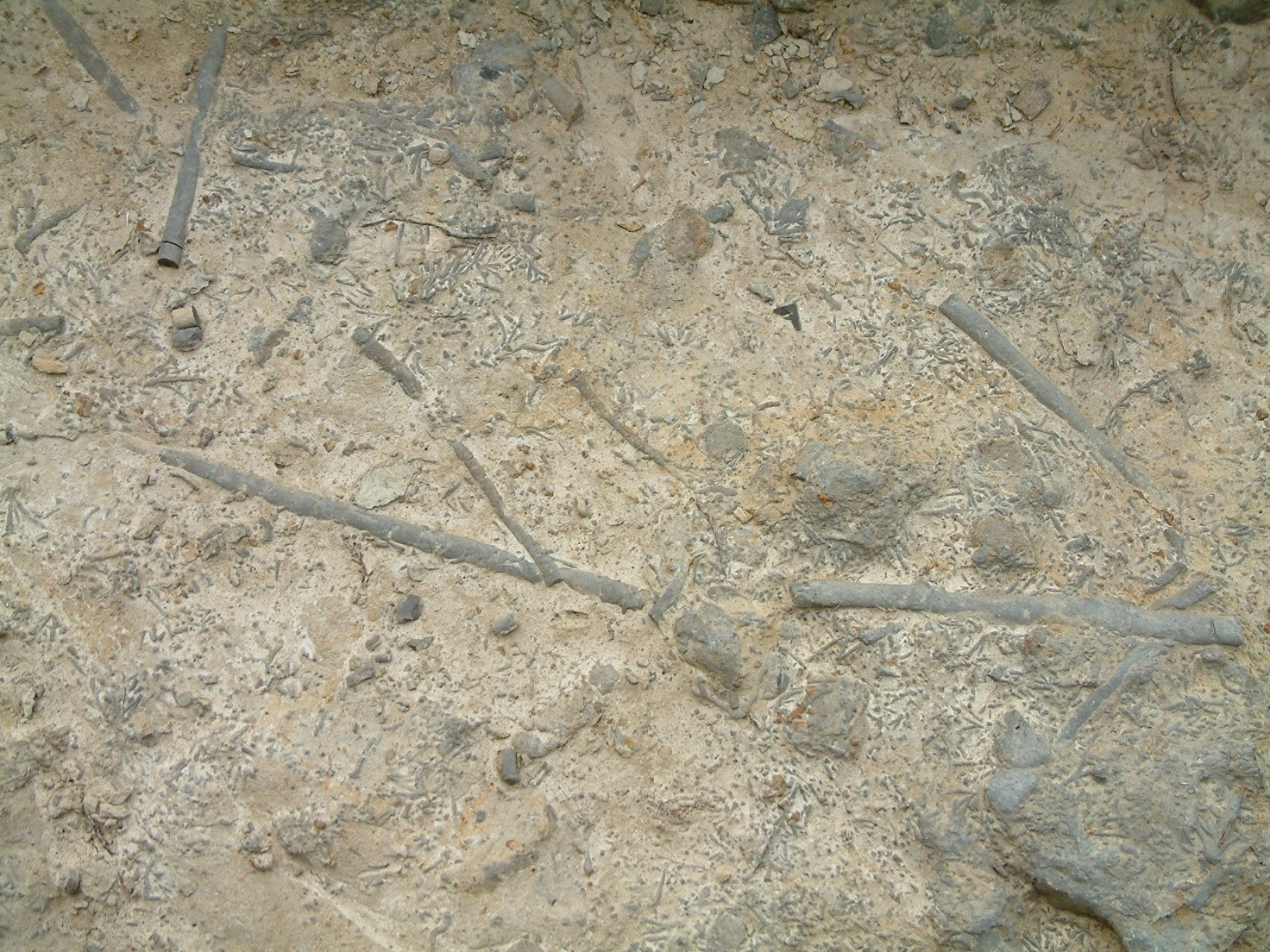
Image by Ruben Rubio from Pixabay.
Because we are not able to cut a slice through the crust, geologists rely on rocks exposed at the surface and in localized trenches or borings to piece together the rock record. The faunal and floral succession of fossils is important for correlating rocks and working out the relative order of occurrences as well as filling in any “gaps” in the rock record in one place by observing them in another.
The Geologic Time Scale
Throughout the 19th century, geologists were able to use these principles to correlate rocks on a global scale, which lead to the assembly of the geologic time scale. The geologic time scale is a diagram that shows the rock succession (rock record) as if we were indeed able to cut a slice through the crust. All of the rocks are shown in relative order. This was a remarkable achievement; however, it was not until the 1898 discovery of radiation by Marie Curie (1867–1934) and the advent of radiometric dating that an absolute time scale could be applied to the geologic time scale (Figure 1.16).
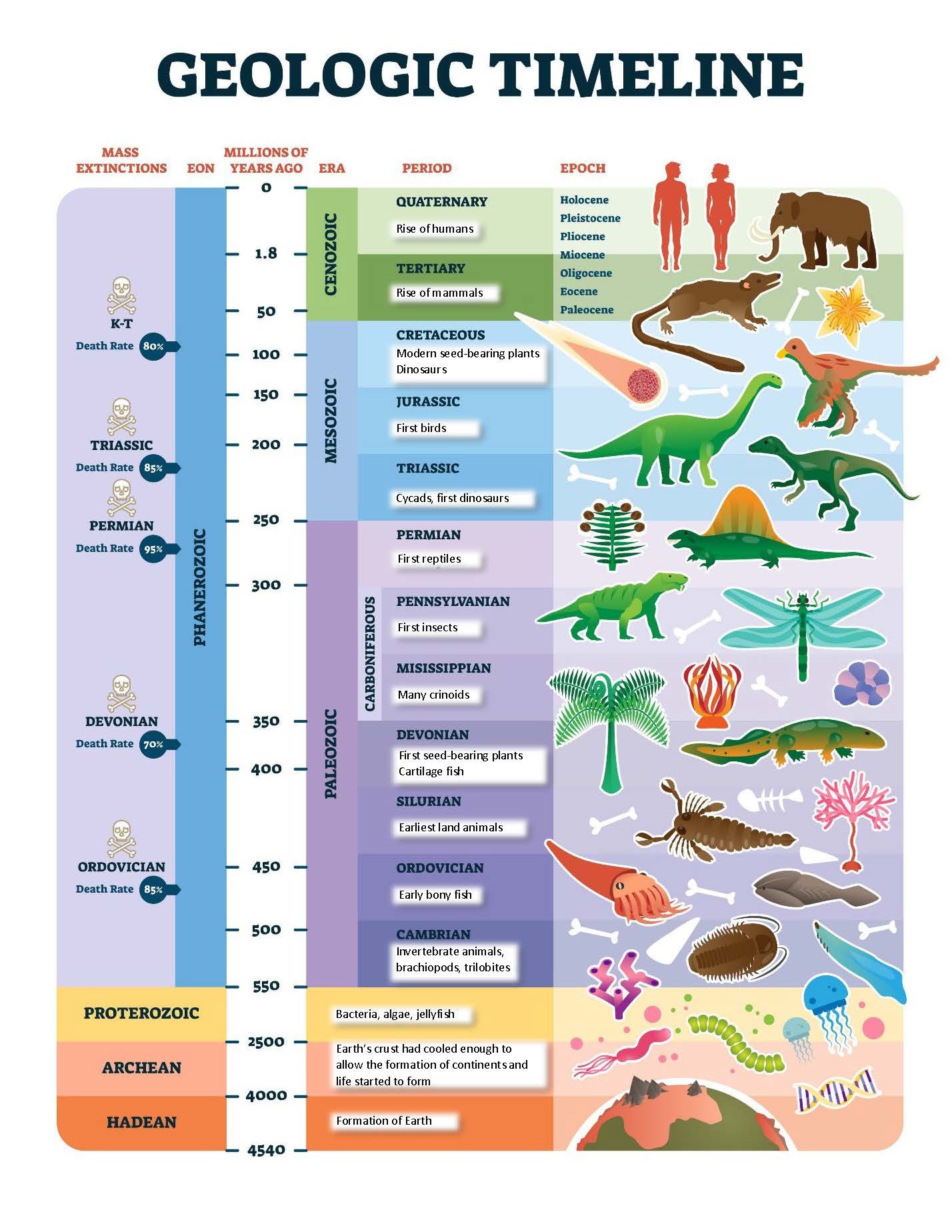
Radiation occurs when unstable radioactive isotopes (atoms with more neutrons than protons) spontaneously emit high-energy particles. Most naturally occurring elements have stable isotopes, but some isotopes are unstable. For example, carbon-12 is a naturally occurring stable element that has six protons and six neutrons in its nucleus; however, carbon-14, which is an isotope of carbon with two more neutrons than protons, is unstable.
As the parent radioactive isotope decays, it emits high-energy alpha or beta particles (by the way, it is this energy that is responsible for Earth’s internal heat) and leaves behind a stable daughter isotope or atom. The rate of decay for a given radioactive isotope is constant, unchanging, in every part of Earth and over time. This property can therefore be used to derive an absolute date for rocks, whose decay does not start until the isotope is formed during crystallization or cooling of molten rock. The date of rocks is achieved by applying the time taken for half the parent atoms to decay into daughter atoms. This property of a substance is called its half-life (Video 1.2).

Click on the image to load the video.
Some radioactive isotopes, such as uranium-238 and lead-206, have half-lives of several billion years. Others, such as carbon-14 to nitrogen-14, have half-lives of several thousand years and act like internal clocks in the rock. Isotopes with short half-lives are useful for dating recent rocks or things of organic origin, while long half-lives allow for dating ancient rocks.
Isotopic or radiometric dating allows the constraining of an absolute time of origin for the rocks in the rock record and therefore for the fossils that are contained within those rocks, along with any evidence of geologic processes. When this dating process is applied to the geologic rock record, we achieve an absolute reference for the geologic time scale.
Just as a note, there is a gap between the age of the oldest rocks or minerals found on Earth and the age of Earth. This is because the rocks of the original crust that formed after the large impactor have been continuously recycled in the mantle through plate tectonic processes (explained in the next chapter). Very few pieces of the original crust would have survived to now. In fact, the oldest rocks found so far, the Acasta Gneiss of the Canadian Shield in northern Canada, formed about 4.0 billion years ago. The oldest date of an Earth material is 4.4 billion years, for a mineral grain of zircon taken from sedimentary rock in Australia. That means that zircon mineral was crystallized as part of an igneous rock 4.4 billion years ago, was uplifted, weathered, transported, and deposited with sediments that would eventually turn into sedimentary rock. Quite a journey!
Earth is currently estimated to be 4.56 billion years old, based on the ages of meteorites and of Apollo-mission-collected Moon rocks, which would have formed about the same time that Earth formed.
Continents consisting of all land on Earth connected, leaving one massive ocean
The system of employing critical thought to investigate natural phenomena
A logical process that uses a specific observation to make a generalization
A tentative explanation based inductive reasoning from empirical evidence
A logical process that goes from the general to the specific
A hypothesis that has become widely accepted
A loose, slowly rotating amalgam of cosmic dust and gas
SiO2
Small spherical astronomical bodies of accreted rock
The sweeping up of debris in the orbital path of planetesimals
Particles of rock in a solar system that are not accreted into larger bodies
Meteoroids that burn up in Earth’s atmosphere
Meteoroids that reach the surface of Earth
In a planetary system, chunks of rock larger than meteoroids but smaller than a planet
The separation of one material into separate constituent materials, as in the division of Earth into separate layers
The thin outer portion of Earth consisting of solid rock
That portion of Earth between the core and crust that consists of semi-molten rock
The inner portion of Earth, consisting of molten iron alloy
The innermost portion of the Earth consisting of a solid iron alloy
The crust of Earth
Minerals with a silicate anion
Minerals with an oxygen anion
The portion of Earth’s core 2890–5150 km deep
The portion of Earth’s core 5150–6370 km deep
Arches of light in the upper atmosphere near the poles. Aurora Borealis at the north pole and aurora Australis at the south pole.
The gaseous “ocean” that surrounds Earth
The water of Earth, in all its phases: solid (ice), liquid (water), and gas (water vapour)
All living organisms on Earth
Cyclic “wobble” in Earth’s axis of rotation
The 23-hour, 56-minute, 4.091-second Earth day
The 24-hour Earth day
Time in the order of millions to billions of years
The principle stating that Earth processes unfolding today unfolded in the same way and at the same rate in the past
A rock layer; pl., strata
Steno’s concept that sediments, with few exceptions, are laid horizontally, such that most nonhorizontal layers have moved after deposition
Steno’s concept that each rock layer in a formation is older than the layer above it
Steno’s concept that sediment layers become thinner the farther the sediments have been carried and that changes in topography can stop the formation of a sediment layer
Lyell’s concept that abrupt interruptions in lateral continuity reflect events that occur after sediments were deposited and lithified
Currently existing rock, considered as reflecting the processes that originated it and the environments in which it formed
Erosive surfaces with younger rocks deposited on top
The pattern by which species of animals (fauna) and plants (flora) come after each other in evolutionary history
A diagram that shows the rock succession (rock record) as if we were indeed able to cut a slice through the crust
The time taken for half the parent atoms to decay into daughter atoms
